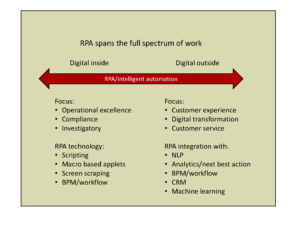The big deal with robotic process automation
I am literally amazed at the enthusiastic level of interest/hype in robotic process automation, also known as intelligent automation. It’s been a long time since I’ve seen hardened IT execs and seasoned business people get so excited by a technology (much less a non-glamourous product category that automates clerical/administrative work.) Need some examples? Here’s a few:
- In August, at a PEX conference (which stands for process excellence) all the RPA sessions were packed to standing room-only level. In a few instances, attendees were spilling out into the hallways.
- Yesterday, I watched an RPA/IA webinar presented by KPMG and Kofax, sponsored by the Institute for Robotic Process Automation and Artificial Intelligence. The moderator mentioned that nearly 1000 participants were dialed in. When is the last time you’ve been involved in a technology webinar that drew that many real-time listeners?
- Recently, I moderated an AI panel at Cybage’s Executive forum. Of all the exciting AI technologies to spotlight, RPA and bots were singled out for special attention in the title of the session.
I could go on and on. Bots–whether robots or chatbots or some other bot–are all hot, seizing the imagination of business, marketing and IT alike.
But why?
I’m not really sure. (Maybe ERP was super, red hot once upon a time and I’ve just forgotten about it.)
But, to be fair, there is a “there” there. Here are some possible reasons why bots are capturing way more attention these days than other high impact software tools:
- Volume. Robots can perform a massive amount of boring, repetitive work that is otherwise dreary, de-humanizing, drudge-work for people to do. Who wouldn’t want that kind of mindless work to go away?
- Labor savings. The administrative/manual/semi-automated work that robots tackle can be finished in seconds or minutes. In contrast, it could take a person hours to get the same work done. And speed = massive labor savings. For example, a shared services group processes several thousand case files per week, with each case requiring two or more hours work. Intelligent automation software processes a case in 30-60 seconds and the entire case workload can be processed overnight.
- Speed of business. So many industries are now hypercompetitive, requiring work to be processed instantly. For example, Wall Street, the City of London and other financial districts require hyperspeeds to stay in business. Removing clerical work can make a huge difference. Any way you measure it, machine speed is far superior to human speed.
- Accuracy. Sometimes error-free work is more valuable than faster work. Intelligent automation wins again by cutting way, way down on mistakes. Errors are introduced whenever there’s sheer boredom and fatigue involved in doing low-value clerical work, such as copying and pasting data from one software app to another, retrieving data from an external portal and putting it into e-mails, and so forth. Investigatory, compliance and customer-facing work would all greatly benefit from high accuracy levels (executed at lightening fast speeds.)
- Priority. RPA is hot in part because companies often limp along with unintegrated systems that are not high enough priority to warrant IT developing APIs. When so many unintegrated business systems, websites, portals, and email systems begin to stack up, some workers may think the entire business is mired down in unworkable systems. Yet IT may be working at breakneck speed to deploy a single strategic business system. Robots can make a huge (albeit stop-gap) difference if the lack of integration is a bottleneck.
But RPA doesn’t have to stay in the equivalent of the digital basement. While some of the clerical, swivel-chair work is a temporary solution until more integrated, modernized IT systems are deployed, there’s also a role for RPA or IA (take your pick) in more cutting edge solutions. This is particularly the case when companies implement and automate end-to-end business processes that not only deliver great customer experiences but also provide operational excellence. (This is where digital outside meets digital inside.) In these instances, RPA may be combined with other technologies such as CRM, predictive analytics, next best action, natural language processing, and other technologies. At PegaWorld this year, I heard several banks and financial services companies describe how they had combined RPA with other technologies in support of cross-functional processes. It is a totally different but equally valid way to conceive of RPA (see figure below).
Still, I think it’s fair to put RPA and IA into perspective instead of joining the hype bandwagon. The reality is that RPA can save companies a ton of money in labor costs. That makes it exciting and worth spending time to understand and use. But the huge wave of new technology–especially AI– that will coming at us over the next few years is mind-blowing. As a CEO on my Cybage panel said, “think of RPA as yet another tool you have in the AI inventory.” Good advice.










